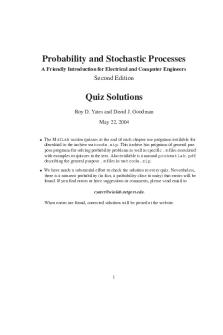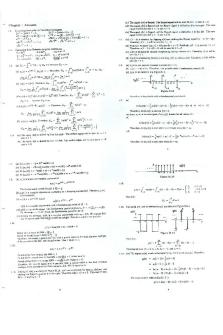Fundamentals of Communication Systems 2nd Edition by Proakis Salehi Solution Manual PDF

| Title | Fundamentals of Communication Systems 2nd Edition by Proakis Salehi Solution Manual |
|---|---|
| Author | Fadi Hantouli |
| Course | Digital Signal Processing |
| Institution | Kennesaw State University |
| Pages | 75 |
| File Size | 1.5 MB |
| File Type | |
| Total Downloads | 91 |
| Total Views | 128 |
Summary
Download Fundamentals of Communication Systems 2nd Edition by Proakis Salehi Solution Manual PDF
Description
Chapter 2
Problem 2.1 1. Π (2t + 5) = Π 2 t + 25 . This indicates first we have to plot Π(2t) and then shift it to left by
5 2.
A plot is shown below:
Π (2t + 5) ✻ 1
− 11 4 2.
✲ t
− 94
P∞
n=0 Λ(t − n) is a sum of shifted triangular pulses. Note that the sum of the left and right side of triangular pulses that are displaced by one unit of time is equal to 1, The plot is given below
x2 (t) ✻ 1
✲ t
−1
3. It is obvious from the definition of sgn(t) that sgn(2t) = sgn(t). Therefore x3 (t) = 0. 4. x4 (t) is sinc(t) contracted by a factor of 10.
1
0.8
0.6
0.4
0.2
0
−0.2
−0.4 −1
−0.8
−0.6
−0.4
−0.2
3
0
0.2
0.4
0.6
0.8
1
Problem 2.2
1. x[n] = sinc(3n/9) = sinc(n/3).
1
0.8
0.6
0.4
0.2
0
−0.2
−0.4 −20
2. x[n] = Π
n
4 −1
3
. If − 12 ≤
−15
n 4 −1
3
−10
−5
0
5
10
15
20
≤ 21 , i.e., −2 ≤ n ≤ 10, we have x[n] = 1.
1
0.9
0.8
0.7
0.6
0.5
0.4
0.3
0.2
0.1
0 −20
3. x[n] =
for n ≥
−15
−10
n n 4 u−1 (n/4) − ( 4 − 1)u−1 (n/4 n n 4, x[n] = 4 − 4 + 1 = 1.
−5
0
5
10
15
20
− 1). For n < 0, x[n] = 0, for 0 ≤ n ≤ 3, x[n] = 4n and
4
1
0.9
0.8
0.7
0.6
0.5
0.4
0.3
0.2
0.1
0 −5
0
5
10
15
20
Problem 2.3 x1 [n] = 1 and x2 [n] = cos(2π n) = 1, for all n. This shows that two signals can be different but their sampled versions be the same.
Problem 2.4 Let x1 [n] and x2 [n] be two periodic signals with periods N1 and N2 , respectively, and let N = LCM(N1 , N2 ), and define x[n] = x1 [n]+x2 [n]. Then obviously x1 [n +N] = x1 [n] and x2 [n +N] =
x2 [n], and hence x[n] = x[n + N], i.e., x[n] is periodic with period N. For continuous-time signals x1 (t) and x2 (t) with periods T1 and T2 respectively, in general we cannot find a T such that T = k1 T1 = k2 T2 for integers k1 and k2 . This is obvious for instance if T1 T1 = 1 and T2 = π . The necessary and sufficient condition for the sum to be periodic is that T2 be a rational number.
Problem 2.5 Using the result of problem 2.4 we have: 1. The frequencies are 2000 and 5500, their ratio (and therefore the ratio of the periods) is rational, hence the sum is periodic. 2. The frequencies are 2000 and
5500 π .
Their ratio is not rational, hence the sum is not periodic.
3. The sum of two periodic discrete-time signal is periodic. 5
4. The fist signal is periodic but cos[11000n] is not periodic, since there is no N such that cos[11000(n + N)] = cos(11000n) for all n. Therefore the sum cannot be periodic.
Problem 2.6 1) e−t x1 (t) = −et 0
t>0 t0 t < 0 = −x1 (t) t=0
Thus, x1 (t) is an odd signal π π 2) x2 (t) = cos 120π t + 3π is neither even nor odd. We have cos 120πt + 3 = cos 3 cos(120πt)− π π sin π 3 sin(120πt). Therefore x2e (t) = cos 3 cos(120πt) and x2o (t) = − sin 3 sin(120πt). (Note: This part can also be considered as a special case of part 7 of this problem) 3) x3 (t) = e−|t| =⇒ x3 (−t) = e−|(−t)| = e−|t| = x3 (t) Hence, the signal x3 (t) is even. 4) 0 t t ≥0 =⇒ x4 (−t) = x4 (t) = −t 0 t lim T = ∞ T →∞ T →∞ T T →∞ T =
lim
Thus the signal x2 (t) is not a power-type signal. 3) Ex Px
=
lim
T 2
Z
T →∞ − T2
1 T →∞ T
=
lim
Z
x 23 (t)dx T 2
− T2
= lim
T →∞
Z
T 2
2
− T2
sgn2 (t)dt = lim
T →∞
sgn (t)dt = lim
T →∞
1 T
Z
T 2
− T2
dt = lim
T →∞
Z
T 2
− T2
dt = lim T = ∞ T →∞
1 T =1 T
The signal x3 (t) is of the power-type and the power content is 1. 4) First note that lim
T 2
Z
T →∞ − T2
A cos(2π f t)dt =
∞ X
A
k=−∞
Z k+
1 2f
1 k− 2f
cos(2π f t)dt = 0
so that lim
Z
T 2
2
T →∞ − T 2
2
A cos (2π f t)dt
1 = lim T →∞ 2
Z
1 T →∞ 2
Z
=
Ex
= =
lim
Z
lim
Z
T →∞
T →∞
T 2
− T2 − T2
=
T →∞
− T2 T 2
− T2
(A2 + A2 cos(2π 2f t))dt A2 dt = lim
T →∞
1 2 A T =∞ 2
(A2 cos2 (2π f1 t) + B 2 cos2 (2π f2 t) + 2AB cos(2πf1 t) cos(2π f2 t))dt
T 2
AB lim
lim
T 2
Z
A2 cos2 (2πf1 t)dt + lim T →∞
T 2
− T2
Z
T 2
−2T
B 2 cos2 (2π f2 t)dt +
[cos2 (2π (f1 + f2 ) + cos2 (2π(f1 − f2 )]dt
∞+∞+0 = ∞
Thus the signal is not of the energy-type. To test if the signal is of the power-type we consider two cases f1 = f2 and f1 ≠ f2 . In the first case Px
T 2
=
1 T →∞ T
=
1 lim (A + B)2 T →∞ 2T
lim
Z
− T2
(A + B)2 cos2 (2π f1 )dt
8
Z
T 2
− T2
dt =
1 (A + B)2 2
If f1 ≠ f2 then Px
T 2
1 T
Z
1 = lim T →∞ T
"
=
lim
T →∞
− T2
(A2 cos2 (2π f1 t) + B 2 cos2 (2π f2 t) + 2AB cos(2πf1 t) cos(2πf2 t))dt
A2 T B 2 T + 2 2
#
=
A2 B2 + 2 2
Thus the signal is of the power-type and if f1 = f2 the power content is (A + B )2 /2 whereas if f1 ≠ f2 the power content is 21(A2 + B 2 )
Problem 2.8 P∞ x(t − 4n). First we plot x(t) then by shifting 1. Let x(t) = 2Λ 2t − Λ(t), then x1 (t) = n=−∞ it by multiples of 4 we can plot x1 (t). x(t) is a triangular pulse of width 4 and height 2 from which a standard triangular pulse of width 1 and height 1 is subtracted. The result is a trapezoidal pulse, which when replicated at intervals of 4 gives the plot of x1 (t). x1 (t) ✻ 1 −6
−2
2
✲ t
6
2. This is the sum of two periodic signals with periods 2π and 1. Since the ratio of the two periods is not rational the sum is not periodic (by the result of problem 2.4) 3. sin[n] is not periodic. There is no integer N such that sin[n + N] = sin[n] for all n.
Problem 2.9 1) 1 Px = lim T →∞ T
Z
T 2 −T 2
A
2
2 ej(2πf0 t+θ)
1 dt = lim T →∞ T
Z
T 2 −T 2
A2 dt = lim T →∞
1 2 A T = A2 T
Thus x(t) = Aej (2πf0 t+θ) is a power-type signal and its power content is A2 . 2) 1 T →∞ T
Px = lim
Z
T 2
A2 cos2 (2π f0 t + θ) dt = lim −T 2
T →∞
1 T
Z
T 2 −T 2
A2 1 dt + lim 2 T →∞ T
Z
T 2 −T 2
A2 cos(4π f0 t + 2θ) dt 2
As T → ∞, the there will be no contribution by the second integral. Thus the signal is a power-type 2 signal and its power content is 2A . 9
3) 1 T →∞ T
Px = lim
Z
T 2 −T 2
1 T →∞ T
2 u−1 (t)dt = lim
Z
T 2
0
dt = lim
T →∞
1 1T = 2 T 2
Thus the unit step signal is a power-type signal and its power content is 1/2 4) Ex
= =
lim
T →∞
T 2
Z
−T 2
x 2 (t)dt = lim
√ 1 lim 2K 2 T 2 = ∞
Z
T 2
T →∞ 0
T →∞
T /2 1 1 K 2 t −2 dt = lim 2K 2 t 2 T →∞
0
Thus the signal is not an energy-type signal.
Px
ZT 1 2 2 −1 x (t)dt = lim K t 2 dt −T T →∞ T 0 2 T /2 √ 1 1 1 1 2 1 = lim 2K 2 (T /2) 2 = lim 2K 2 T − 2 = 0 = lim 2K t 2 T →∞ T T →∞ T T →∞ 0
1 = lim T →∞ T
Z
T 2
2
Since Px is not bounded away from zero it follows by definition that the signal is not of the powertype (recall that power-type signals should satisfy 0 < Px < ∞).
Problem 2.10 t + 1, −1 ≤ t ≤ 0 Λ(t) = −t + 1, 0 ≤ t ≤ 1 0, o.w.
1
u−1 (t) = 1/2 0
t>0 t=0 t...
Similar Free PDFs

2nd edition quiz solution
- 83 Pages
Popular Institutions
- Tinajero National High School - Annex
- Politeknik Caltex Riau
- Yokohama City University
- SGT University
- University of Al-Qadisiyah
- Divine Word College of Vigan
- Techniek College Rotterdam
- Universidade de Santiago
- Universiti Teknologi MARA Cawangan Johor Kampus Pasir Gudang
- Poltekkes Kemenkes Yogyakarta
- Baguio City National High School
- Colegio san marcos
- preparatoria uno
- Centro de Bachillerato Tecnológico Industrial y de Servicios No. 107
- Dalian Maritime University
- Quang Trung Secondary School
- Colegio Tecnológico en Informática
- Corporación Regional de Educación Superior
- Grupo CEDVA
- Dar Al Uloom University
- Centro de Estudios Preuniversitarios de la Universidad Nacional de Ingeniería
- 上智大学
- Aakash International School, Nuna Majara
- San Felipe Neri Catholic School
- Kang Chiao International School - New Taipei City
- Misamis Occidental National High School
- Institución Educativa Escuela Normal Juan Ladrilleros
- Kolehiyo ng Pantukan
- Batanes State College
- Instituto Continental
- Sekolah Menengah Kejuruan Kesehatan Kaltara (Tarakan)
- Colegio de La Inmaculada Concepcion - Cebu














